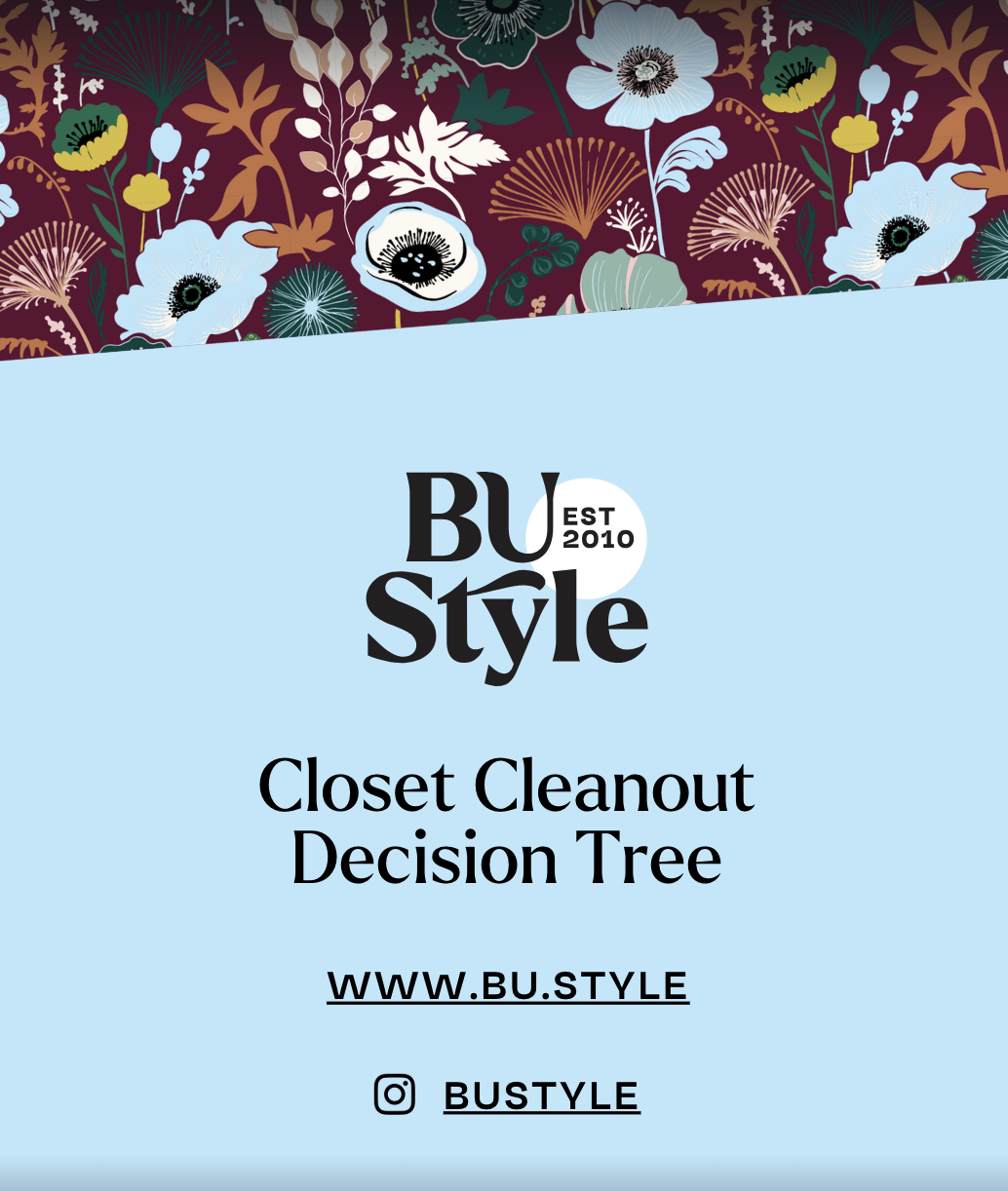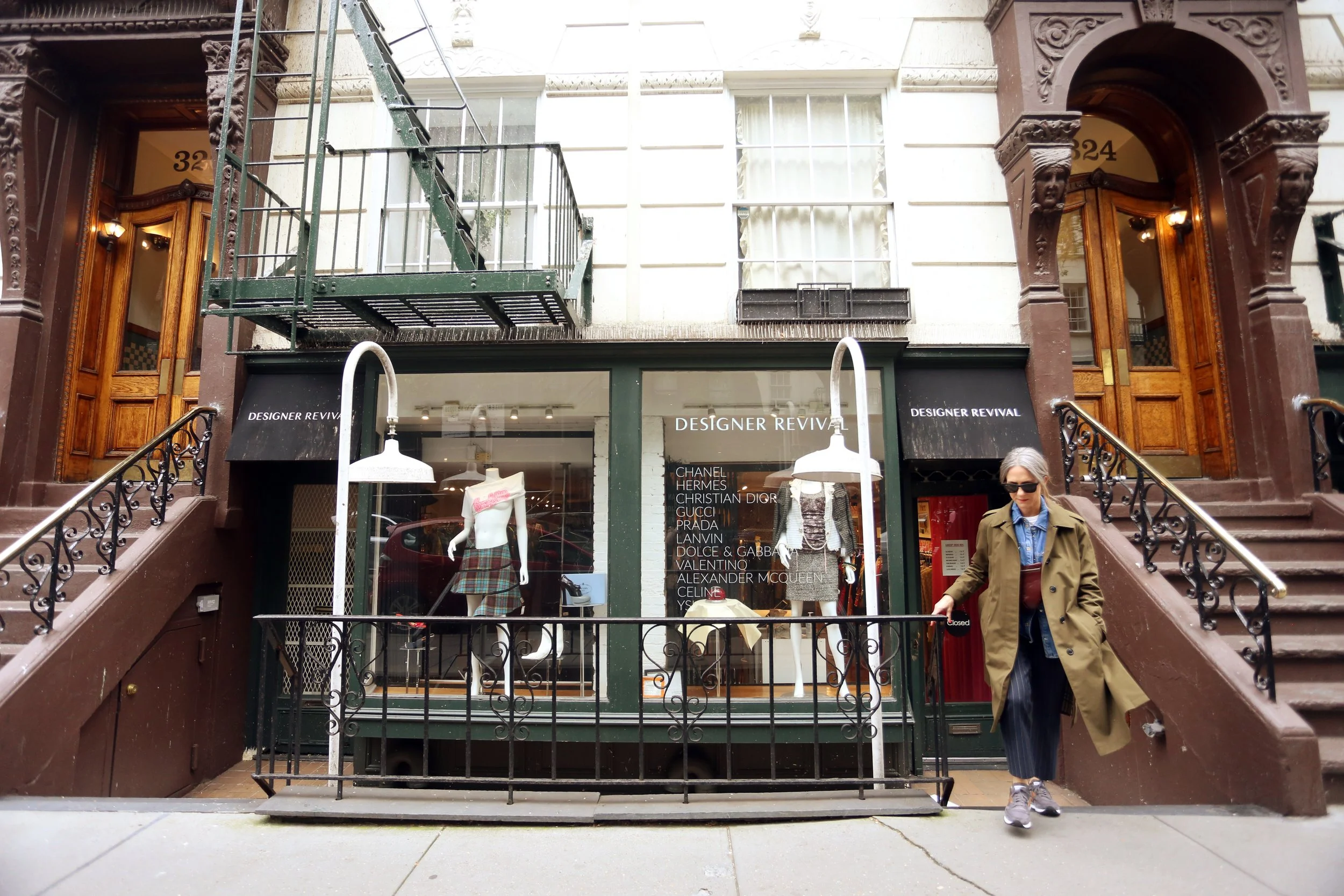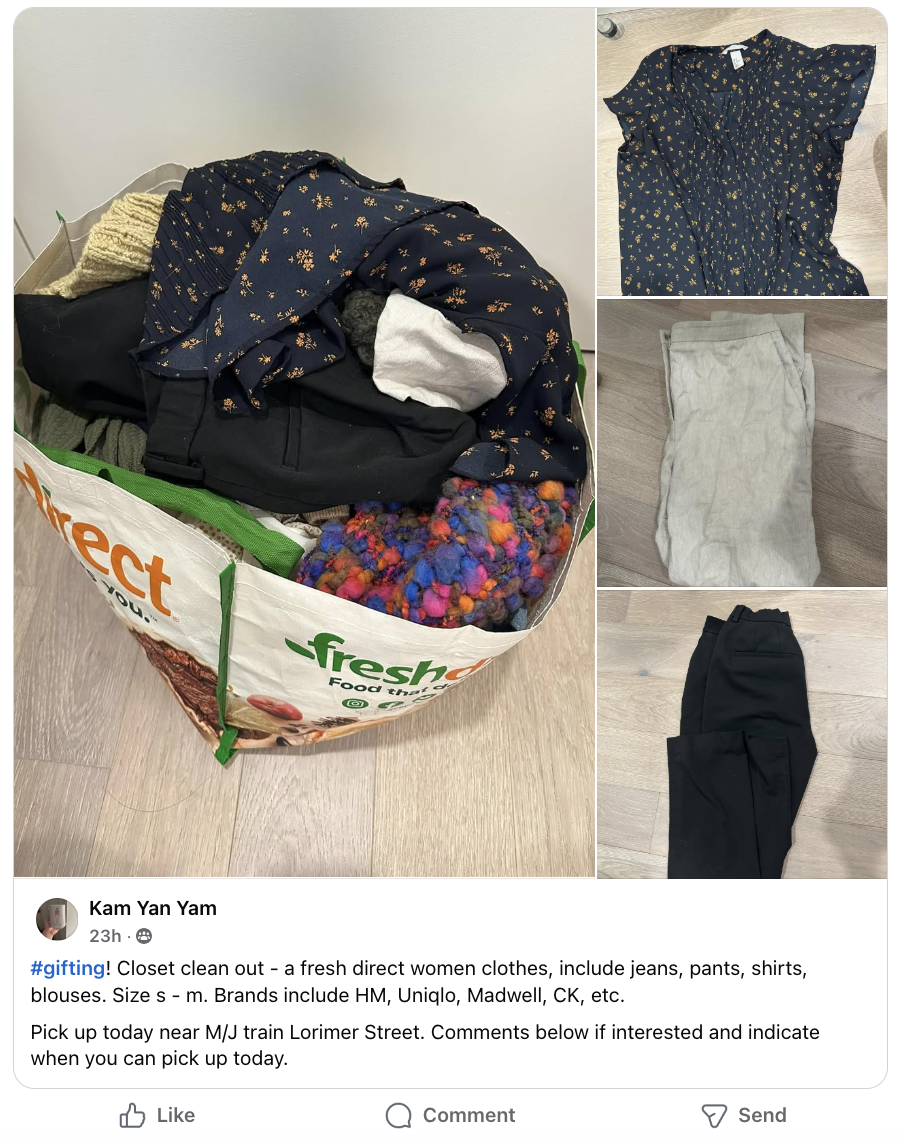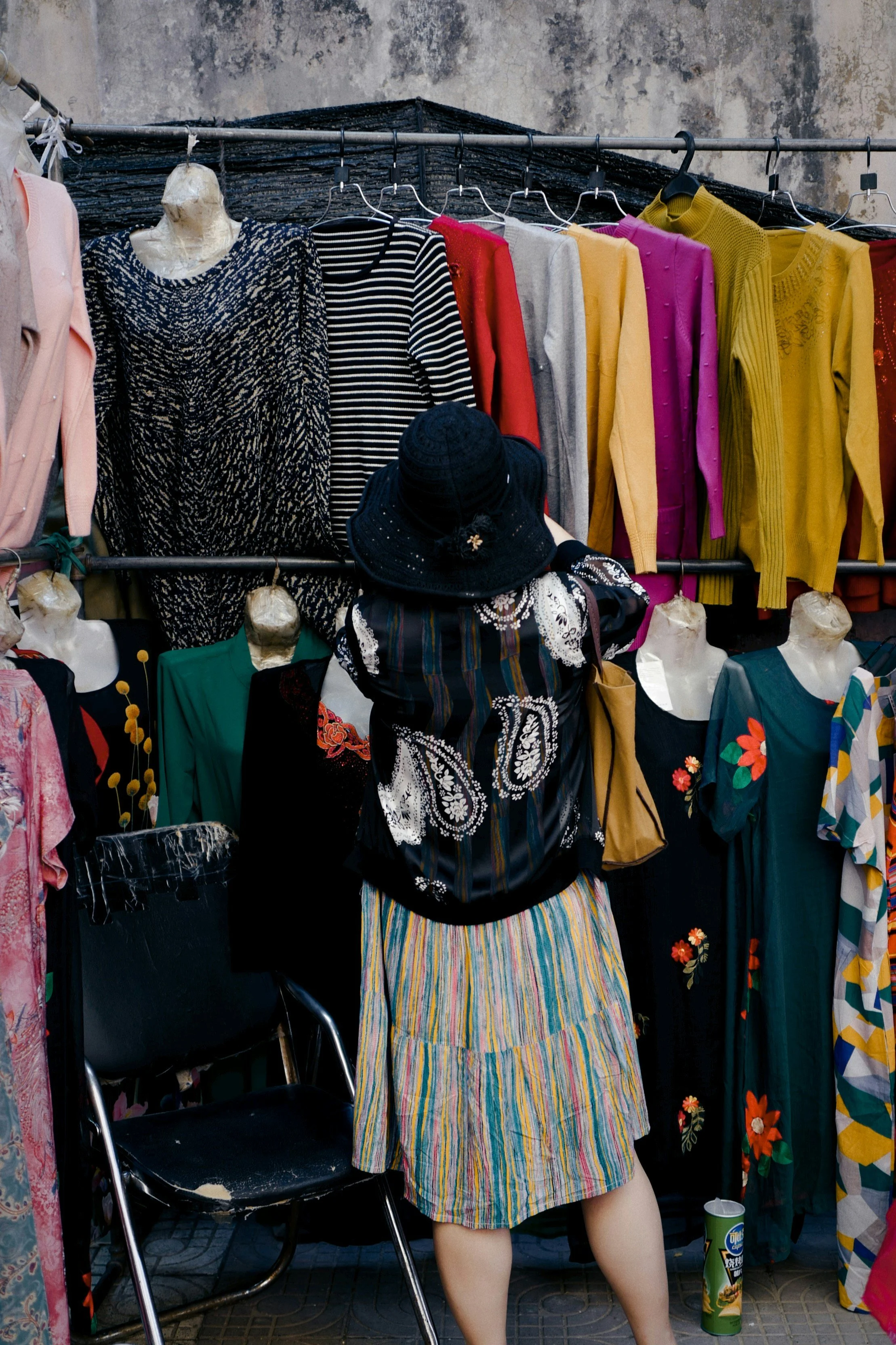Give Your Clothes a New Opportunity: Resources Post Closet Cleanout
Pre-loved, pre-owned, second-hand, used… There are a lot of synonyms for places to find previously owned clothes. A lot of these options involve consignment or thrift stores, which in many other countries are known as “opp shops.”
But what does “opp shop” mean?
Opportunity.
And how lovely is that! My goodness! Instead of focusing on the diminished life of a clothing item (i.e., pre, used, etc.), how about we focus on how much life it has left? The opportunity and possibilities of a clothing item after it’s spent a year wallowing in the back of your chest-of-drawers?
So! Seeing as an aspect of BU Style is focused on decluttering closets and simplifying what you own for maximum impact, we wanted to offer some lesser-known resources so that you can find new opportunities for your clothes in their next life.
Pro-Tip: Launder your clothes before donating or selling. Make sure they’re in good condition. Focus on the “loved” part of “pre-loved.”
Wait! Not sure which clothes to keep? Try our Closet Cleanout Decision Tree!
It can be intimidating to know what to keep and what to toss and what to get tailored. Try our Closet Cleanout Decision Tree to help you understand exactly what to do with each item in your closet. Through a series of detailed questions, you’ll discover exactly what each piece needs and what to do next!
So where should you go to sell your clothes? Try selling at consignment shops!
Consignment shops are a fantastic way to explore fashion while making eco-conscious choices. In fact, studies show that the global resale market is expected to reach $128 billion by 2026, reflecting a growing trend in sustainable fashion (and perhaps a desire for vintage aesthetics). Consignment stores offer a unique blend of affordability and quality, allowing shoppers to discover gently used designer items at a fraction of their original prices (for real—check them out). More than thrift stores, consignment shops are known for curating their selections, ensuring that only the best items make it to the racks. Less work for the consumer! Also, when you shop at a local consignment store, you’re not only supporting small businesses but also engaging with staff who can often share the stories or fashion history behind some of the items. It’s a special thing that makes shopping secondhand different!
Why is consigning your clothes right for you?
Francois Le Nguyen via Unsplash
The fast fashion industry is increasingly recognized for its significant environmental and social impacts. Major retailers like Zara, H&M, and Forever 21 produce inexpensive clothing at a rapid pace, contributing to about 10% of global carbon emissions and generating immense textile waste—85% of which ends up in landfills annually. The production of a single cotton shirt requires around 700 gallons of water, and microplastics from synthetic fabrics are polluting our oceans.
Beyond environmental concerns, the industry often relies on exploitative labor practices, including forced and child labor in developing countries. High-profile tragedies, such as the 2013 Rana Plaza collapse in Bangladesh, have highlighted these issues.
In response, the concept of "slow fashion" has gained traction. This movement encourages consumers to prioritize quality over quantity, opting for sustainable practices like renting, repairing, or repurposing clothing. As awareness of fast fashion's toll grows, both consumers and businesses are increasingly called to embrace more responsible choices that balance style with social and environmental considerations.
Here’s how the consignment process works:
Bring in or Ship Your Stuff: If you have clothes or items you no longer need, you can take them to a consignment shop. They usually have guidelines about what they accept, so it’s a good idea to check that first. The items should be clean and in good condition.
The Store Takes a Look: The shop staff will review your items to see what they can sell. They’ll consider things like the brand, condition, and what’s currently popular.
Sign an Agreement: If they like your items, you’ll sign a consignment agreement. This outlines the rules, like how long your items will be for sale and how much money you’ll get when they sell.
Your Stuff Goes on Display: After signing, your items will go on the shop floor or online for shoppers to see. The shop handles everything, from pricing to promoting your stuff.
Get Paid: When an item sells, you earn a percentage of the sale price. You typically get paid after a certain period, like once a month. If some items don’t sell within the agreed time, you can usually choose to pick them up or let the shop donate them.
What are BU Style’s favorite consignment shops?
True Fashionistas consignment:
A special shout-out to True Fashionistas! They’re our partner, and we love their mission. They also have home goods. True Fashionistas operates a streamlined consignment process that begins when individuals send in their items for review by a team of professional buyers. As of October 13, 2023, the company transitioned to a policy that no longer offers buyouts for mail-ins; all mailed items will be placed under a 90-day consignment agreement. Clients can choose whether they want their unsold items returned (for a small fee) or donated to a local charity. When shipping items, clients must use the label provided and include a checklist in each box to ensure proper tracking. True Fashionistas uses UPS for shipping, meaning they do not control the delivery timeline or track incoming packages, and their team will not wait for all boxes to arrive before starting the review process. It’s important to note that items should not be shipped in thin boxes to avoid damage. Once the items are evaluated, True Fashionistas will send a text message to the client, so providing a cell phone number is essential, and clients are expected to respond within 48 hours. Any unsold items valued under $25 at the end of the consignment period will be donated.
We love that they have an online consignor portal, so you can track your items and easily request your payouts.
Designer Revival consignment:
BU Style at Designer Revival in NYC
Another shout-out to another one of our favorites, Designer Revival! Designer Revival has been a leader in luxury consignment in New York City for over 30 years. Known for its careful curation and personalized service, the store specializes in high-end designer, contemporary, and vintage fashion, including clothing, handbags, jewelry, shoes, and accessories. Their collection is updated daily with meticulously authenticated pieces, making luxury fashion accessible at various price points. The vintage collection boasts iconic pieces from renowned designers like Azzedine Alaïa, Issey Miyake, Vivienne Westwood, and more…
The website for Designer Revival is also stylish and fabulous and will give you a sense of the types of goods they accept.
Prudence Earl via Unsplash
What is the difference between consignment and thrifting?
While the terms “consignment” and “thrifting” are often used interchangeably, there are very clear differences. Thrift shops, usually donation-based and often non-profit, sell items that have been donated, with proceeds typically going to charity. In contrast, consignment stores operate for profit and pay you a percentage (usually 30%-50%) of the sale price when your items sell.
Thrift shops accept a broad range of goods, which can result in lower-quality items, while consignment stores tend to be more selective, offering higher-quality, curated pieces. Both store types aim to reduce waste by giving preloved items a second life. We love this because it’s making your cost-per-wear lower!
Selling to consignment stores can be personally rewarding since you can earn cash and engage with a community that values your contributions. Shopping at consignment stores allows for a more upscale experience, as items are inspected for quality and style, often at significantly reduced prices compared to their original retail value, including high-end designer pieces. While consignment stores may be pricier than thrift shops, they provide unique, timeless items that have been lovingly curated.
What else can I do if I don’t want to consign my unwanted clothes?
—Buy Nothing or Mutual Aid Groups: These are large collectives (often organized on Facebook) where people post items they’d like to acquire or give away for free. Mutual Aid groups do a good job of providing resources to the neighborhood.
Buy Nothing Groups on Facebook
"Buy Nothing" groups and mutual aid organizations are fantastic and fun ways to give your unused clothes a second life while fostering community spirit, which we love. Multiple members of the BU Style staff are active members of these fab groups, sharing the love by swapping and donating clothes. It’s totally possible to be scrolling through a "Buy Nothing" Facebook group and discover someone who needs that funky sweater you never wear… or a pair of shoes you have lurking in the back of your closet.
Did you know that according to the Council for Textile Recycling, the average American throws away about 81 pounds of clothing each year? By engaging in these community networks, you (yes, you) help counter that statistic while making a new friend or two. Just post about what you’ve got to share, and watch your neighbors jump at the chance to snag something fabulous! Similarly, our active involvement in mutual aid groups means we can not only donate but also help coordinate how clothing gets to those who need it most.
This community has also grown quickly. Did you know that there are around 128,000 Buy Nothing communities around the world today? Amazing!
Billow via Unsplash
—Hospitals: Ask your local hospital if they’re looking for clothes. A lot of patients come in needing more clothes than they have! We recommend calling hospitals to see if they also work with a specific charity, and you can donate that way. Keep in mind you also might be able to donate books/dvds/games. Specific hospital units have different needs.
—Legal Aid Societies: This is a great option if you have some snazzier clothes looking for a home. You’ll be providing court-appropriate attire for clients who have trials and job interviews coming up. If you’re unsure what to Google for your area, try “professional wear donations,” “law firm clothing donations,” “dress for success clothing donations,” or “legal aid clothing donations.”
—Dress for Success: They empower women by providing attire and the development tools to thrive professionally. https://dressforsuccess.org/
—Housing Works: a NYC-based non-profit that provides services to the most vulnerable New Yorkers. Housing Works is a nonprofit in New York City that's truly making a difference in the lives of those affected by homelessness and AIDS. Founded by passionate activists back in 1990, this organization not only provides essential services like healthcare and job training but also operates charming thrift shops and a cozy bookstore café where every purchase supports its mission. What sets Housing Works apart is its commitment to social justice and community engagement—through fun events, advocacy for LGBTQ rights, and even disaster relief efforts in Haiti. People love this charity because it turns compassion into action, giving hope and support to vulnerable populations while fostering a sense of community. Plus, shopping at their thrift stores means you’re helping create a better, more equitable world. It's a powerful way to make a difference with every purchase and donation!
—References: A concierge for your resellable fashion & your proxy for quality local donations and transparent fabric recycling. References is a pioneering NYC-based organization revolutionizing clothing recycling with a unique, membership-enabled service that blends fashion consciousness with climate action. They offer a convenient pickup of clothes and fabrics from your doorstep, paying you upfront for resellable items or returning everything if you prefer. What sets them apart is their commitment to transparency; you can see exactly where your items end up, ensuring they are either donated, resold, or repurposed in the most meaningful way. References aim to minimize waste and foster a more sustainable fashion ecosystem by connecting with grassroots organizations, nonprofits, and businesses.
—If you’re in New York City (like many of our clients) and still stuck for options, try DonateNYC, where you can search places to give, fix, find, or borrow various items, including clothing, furniture, and more. New Yorkers can also try starting with this list! Not in NYC? Check your local government website to see if your area offers the same local resources.
And that should give you a place to start looking for more significant opportunities for your clothes!
Natalie Tincher, founder of BU Style; photo credit Ambe J. Photography
The BU Way: Our personal stylists’ core beliefs on purchase decisions
As we navigate the world of fashion, it's essential to acknowledge the significant environmental and social impact of our purchasing decisions. By embracing consignment shops, “buy nothing” groups, and other community-driven initiatives, we can reduce waste and foster a sense of community.
Remember, one of our core company beliefs is to “buy better, buy less, and wear longer.” As always, we urge you to rethink your relationship with fashion, prioritize quality over quantity, determine your top shopping values, and use those to guide your purchases. Plus, with resources like BU Style, you have the tools to make responsible decisions and drive change in the fashion system for a more equitable (and stylish) future.









